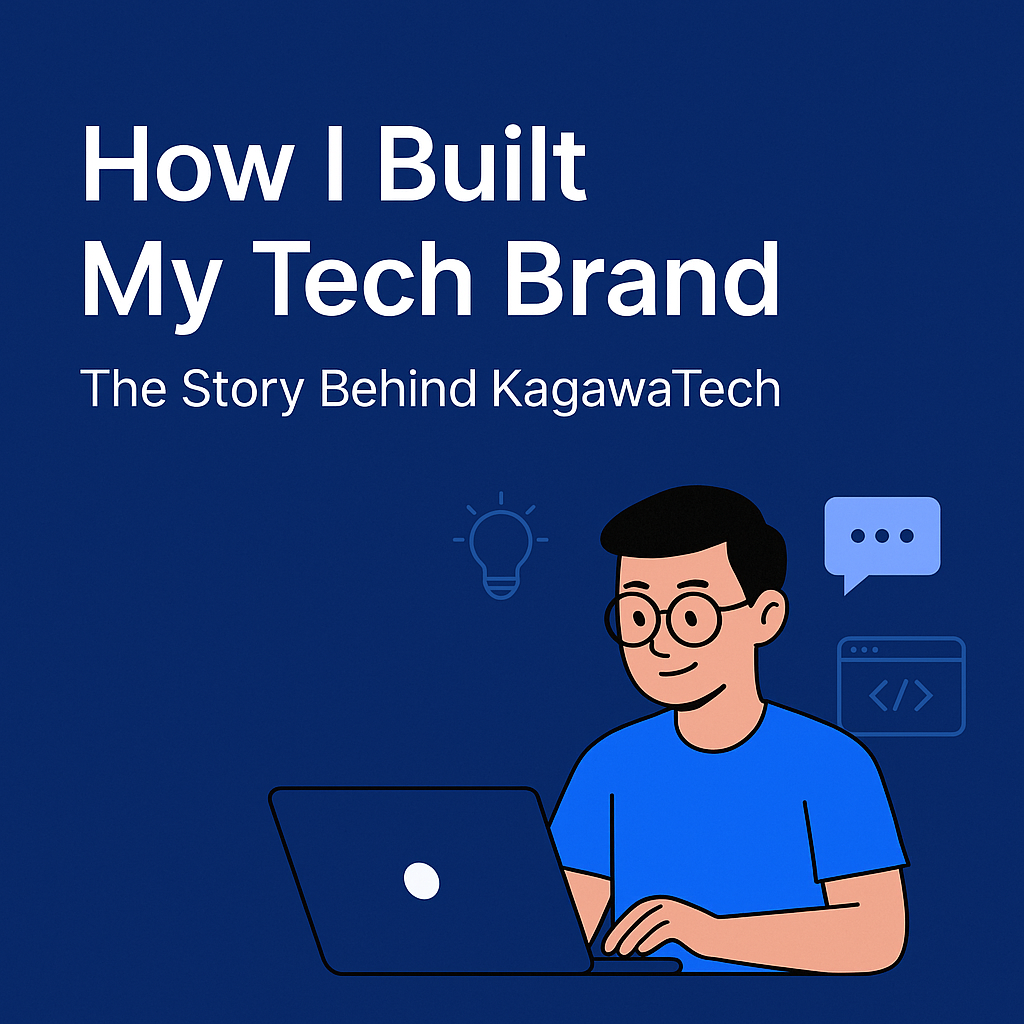Discover how KagawaTech was built—from a simple idea to a personal tech brand. Learn about the challenges, tech stack, key projects, and lessons gained along the journey to inspire your own path in tech.

"Every line of code tells a story—this is mine."
In a world driven by technology, personal brands have become more than just digital portfolios—they're platforms for innovation, impact, and connection. KagawaTech didn’t start as a business or a well-planned venture. It started with a curiosity. A desire to build. A need to contribute something meaningful to the tech world.
Today, KagawaTech represents more than just projects; it represents a mission—to inspire, to solve, and to share. Through this blog, I want to take you behind the scenes: how it all started, the challenges I faced, the tech stack that powers my ideas, the mindset that fuels my work, and the vision that shapes the future of KagawaTech.
Like many in tech, my journey started in the quiet hours of curiosity. I was fascinated by how digital experiences could be created from nothing more than logic and design. As I learned, experimented, and failed forward, I realized I needed a home for everything I was building—a digital space that could reflect my personality, skillset, and aspirations.
That space became KagawaTech.
The name itself was inspired by a blend of culture, innovation, and identity. I wanted something that felt local yet universal, personal yet professional. I didn’t want to hide behind a brand—I wanted my tech brand to be a window into who I was and what I stood for.
From the beginning, I knew KagawaTech had to be more than just a collection of apps and websites. I wanted to build a brand that did three things:
Every project under KagawaTech is built with intention—designed to solve real problems, serve real users, and reflect real-world value.
Let’s be honest—building anything worthwhile isn’t easy. KagawaTech was no exception.
Like many self-taught developers, I constantly questioned whether I was good enough. Comparing myself to others slowed down my growth. But I learned that everyone’s journey is different. Progress, not perfection, is what matters.
Balancing KagawaTech with studies, freelance work, or other responsibilities required strong time management. I had to learn to prioritize, set deadlines, and hold myself accountable.
Broken builds, security bugs, failed deployments—I've seen it all. Each challenge forced me to improve my problem-solving skills. I began documenting everything, writing better tests, and investing time in learning how to debug smarter.
Even with solid content, it took time to attract readers and collaborators. SEO, consistency, and patience helped. Eventually, KagawaTech began to attract attention—and with that came new opportunities.
Behind the scenes of every KagawaTech project is a stack of carefully chosen technologies that enable speed, performance, and scalability.
This stack wasn’t chosen overnight. It’s the result of trial, error, and a deep desire to use tools that balance productivity with performance.
This site itself is a living project—a place where I experiment with design, accessibility, and performance optimization. Every update represents something new I’ve learned.
Key Takeaway: A personal site isn’t a one-time project—it’s an ongoing reflection of your growth.
An Android app built to help students log their daily internship activities. It includes GPS tracking, real-time timestamps, and a reporting dashboard for administrators.
Key Takeaway: Solving real local problems gives your work relevance and impact.
Designed to digitize services commonly offered in Kenyan cyber cafes. It includes features like document printing, customer login, and service requests.
Key Takeaway: Understanding your users is more important than adding flashy features.
A highly scalable chat platform built without Firebase, supporting video/voice calls, status tracking, notifications, and encrypted messaging.
Key Takeaway: Ambitious projects push your limits and force you to master new tools fast.
Branding isn’t just about logos and colors—it's about how people feel when they interact with your work.
At KagawaTech, I’ve tried to build a consistent identity:
Design is often underestimated in tech circles. But a well-designed interface makes your work more approachable, professional, and impactful.
One of the most rewarding decisions I made was to start blogging on KagawaTech. Writing forces you to clarify your thinking. It also builds community, authority, and trust.
Topics I’ve written (or plan to write) about:
My advice? Start writing. Even if you think no one is reading—write for your future self.
Eventually, I started getting freelance inquiries. Some came through referrals, others through my blog and GitHub repos.
Through KagawaTech, I’ve worked on everything from local apps for schools to international product MVPs.
KagawaTech is just getting started. Here’s what’s next:
If you’re starting your own tech brand, here are 10 things I wish I knew earlier:
KagawaTech is as much about community as it is about code. Whether you’re a developer, designer, founder, or just curious about tech, I’d love to connect.
👉 Visit KagawaTech
👉 Follow on GitHub, LinkedIn, or Twitter
👉 Let’s build the future—one project at a time.
Your email address will not be published. Required fields are marked *